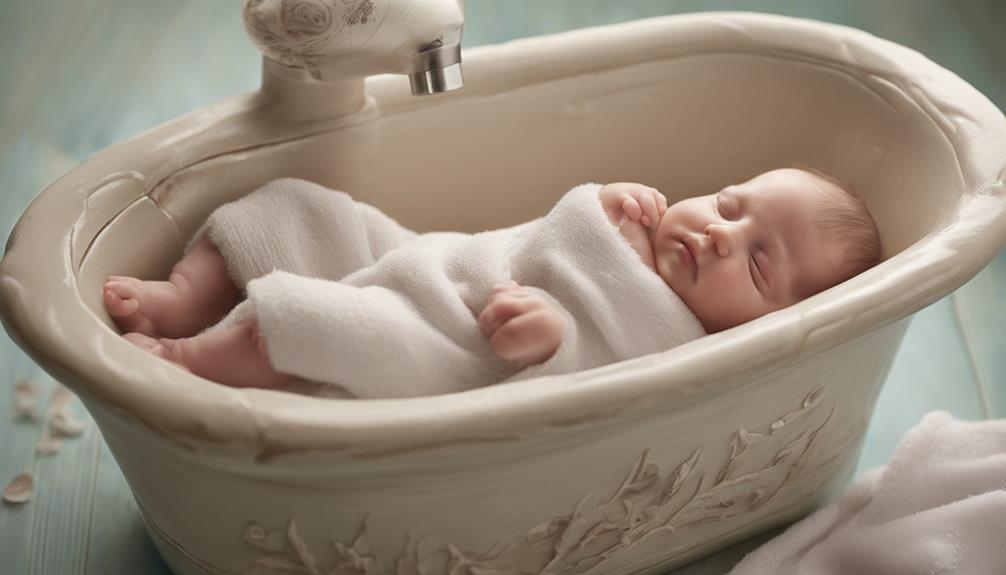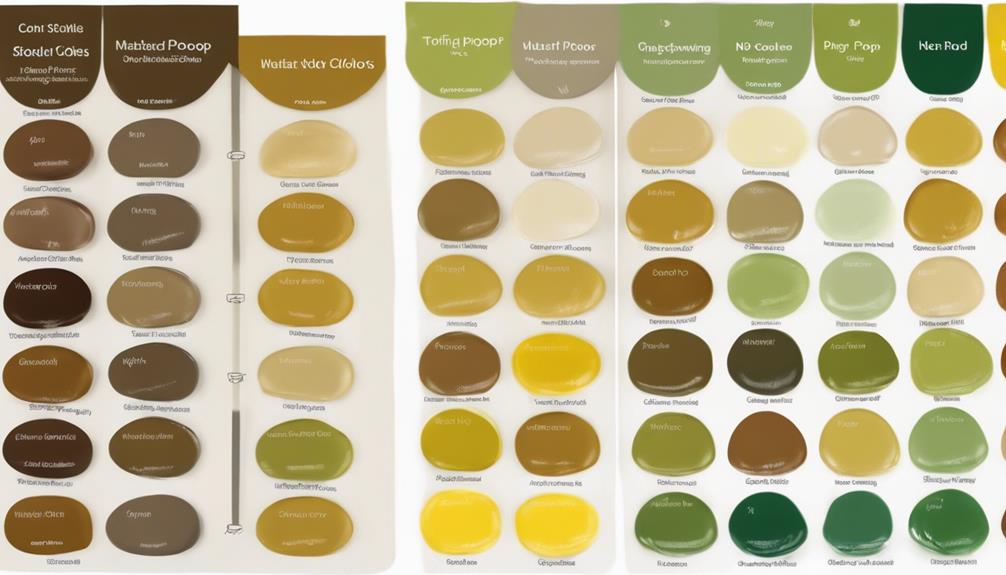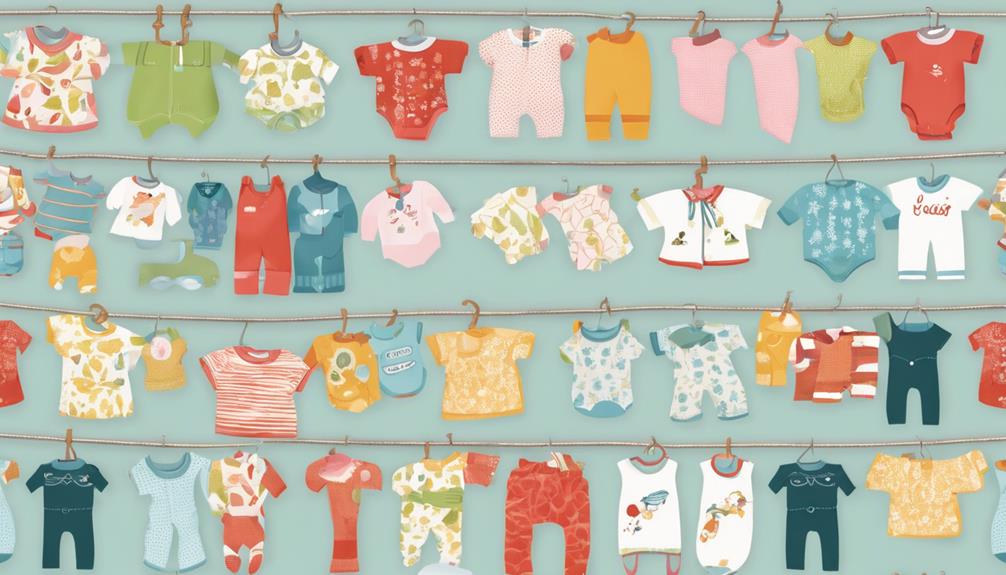When it comes to taking care of **newborns**, learning how to care for a **brand new** life can bring lots of joy and also some tough moments. If you want to master the skills of newborn care, get ready for an exciting journey filled with ups and downs. So, get ready for a rollercoaster of emotions and experiences in the world of newborn care!
From swaddling techniques to soothing strategies, the journey of parenthood is a profound one full of surprises and growth.
As we explore the intricate dance of caring for our little ones, let's uncover the secrets behind creating a secure, loving environment where our babies can thrive.
Key Takeaways
- Maintain a consistent feeding schedule every 2-3 hours for growth and bonding.
- Create a safe sleep environment by placing baby on their back with a firm mattress.
- Respond promptly to newborn cues like rooting and crying to strengthen trust and security.
- Use soothing techniques like skin-to-skin contact and gentle rocking for comfort and bonding.
Establishing a Feeding Routine
When establishing a feeding routine for your newborn, it's important to understand their nutritional needs and feeding patterns. Babies typically require feeding every 2-3 hours to make sure they receive the essential nutrients necessary for their growth and development. Whether you choose breastfeeding or formula feeding, the key is to maintain a consistent schedule that works for both you and your baby.
Breastfeeding not only provides important nutrients but also fosters a deep bond between parents and their newborn.
Tracking feeding times and amounts can help make sure that your baby is getting enough nutrition. It's normal for newborns to have varying appetites, so being attentive to their cues is essential. If breastfeeding isn't an option, formula feeding can be a suitable alternative.
Diapering Basics

Let's talk about the essentials of diapering your newborn.
Changing diapers frequently is key to keeping your baby comfortable and free from diaper rash.
Remember to use diaper cream and dispose of diapers properly to maintain good hygiene practices.
Changing Techniques
To guarantee your newborn's comfort and hygiene, mastering proper diaper-changing techniques is essential. During diaper changes, remember to wipe gently from front to back to prevent infections, especially while caring for the umbilical cord area.
Make sure to secure diapers snugly but not too tight to keep your baby comfortable and prevent leaks. Proper disposal of used diapers is important for maintaining hygiene and cleanliness in your baby's environment. If you're interested in an eco-friendly option, consider using cloth diapers as an alternative to disposable ones.
Hygiene Essentials
Ensuring proper diapering techniques is crucial for maintaining your newborn's hygiene and comfort. To care for your baby effectively, change diapers frequently (about 10 times a day) to prevent diaper rash and keep your little one clean. Use diaper cream to protect their delicate skin from irritation caused by wetness. Remember to secure diapers snugly but not too tight to guarantee both comfort and leak prevention. Additionally, dispose of diapers properly in a designated pail or bin to uphold cleanliness. For a more sustainable option, consider eco-friendly cloth diapers. Prioritizing these steps will help keep your baby comfortable and healthy.
| Diapering Tips | Description |
|---|---|
| Change Frequently | Change diapers approximately 10 times a day to prevent diaper rash and maintain hygiene. |
| Use Diaper Cream | Apply diaper cream to protect the baby's skin from irritation and redness due to prolonged wetness exposure. |
| Secure Fit | Ensure diapers are snug but not too tight to provide comfort and prevent leaks. |
| Proper Disposal | Dispose of soiled diapers in a designated pail or trash bin to maintain cleanliness. |
| Eco-Friendly | Consider using eco-friendly cloth diapers as a sustainable alternative to disposable diapers. |
Creating a Safe Sleep Environment
Let's talk about creating a safe sleep environment for your newborn.
Remember to always place your baby on their back to sleep to reduce the risk of Sudden Infant Death Syndrome (SIDS).
Avoid soft bedding, blankets, or pillows in the crib to maintain a firm sleep surface and prevent suffocation.
Safe Crib Setup
For a secure and peaceful sleep environment, prioritize placing the crib away from potential hazards such as windows, cords, and blinds. Ensuring the crib mattress fits snugly with no gaps larger than two fingers prevents entrapment. Remove soft bedding, pillows, blankets, and toys from the crib to reduce the risk of suffocation. Check for recalls and ensure the crib meets safety standards for a secure sleep environment. Use a firm mattress and fitted sheet to maintain a safe and comfortable sleeping space for your newborn. Remember, a safe crib setup is crucial for your baby's well-being. Below is a helpful guide to setting up a safe crib for your little one:
| Safe Crib Setup | Tips |
|---|---|
| Crib Location | Away from hazards like windows, cords, and blinds |
| Mattress | Snug fit with no gaps larger than two fingers |
| Bedding | Remove soft items to reduce suffocation risk |
SIDS Prevention Tips
Prioritizing your newborn's safety during sleep is paramount, especially when considering SIDS Prevention Tips for creating a secure sleep environment.
Always remember to place your baby on their back to sleep, as this markedly reduces the risk of Sudden Infant Death Syndrome (SIDS).
It's recommended for parents to share a bedroom with the baby (but not a bed) for the first 6 months to 1 year, as this proximity can aid in monitoring and comforting the infant.
Changing the position of your baby's head from night to night can prevent the development of a flat spot on the skull.
Additionally, guarantee the baby isn't overheated during sleep to lower the risk of SIDS.
If you have any questions or concerns about safe sleeping practices and SIDS prevention, don't hesitate to consult a doctor.
Understanding Newborn Cues

Understanding newborn cues is essential for responding promptly to your baby's needs and fostering a strong bond from the very beginning. When caring for your newborn baby, paying attention to their cues can provide valuable insights into their well-being and help you meet their needs effectively.
Here are three key points to ponder:
- Recognizing Cues: Newborn cues such as rooting, sucking, crying, and hand-to-mouth movements are ways your baby communicates their needs. By understanding these cues, you can decipher whether your baby is hungry, uncomfortable, tired, or seeking comfort.
- Prompt Response: Responding promptly to your baby's cues, especially when it comes to feeding and comforting, can help build trust and security. Meeting your baby's needs in a timely manner can also prevent unnecessary distress and promote a sense of safety.
- Bonding Through Cues: Reading and responding to your baby's cues not only assures their well-being but also strengthens the bond between you and your baby. This early form of communication sets the foundation for a nurturing relationship based on understanding and care.
Soothing Techniques for Comfort

When seeking to provide comfort to your newborn, incorporating soothing techniques can greatly enhance your bonding experience and promote a sense of security for your baby. One effective way to soothe your baby is through skin-to-skin contact, which fosters closeness and comfort between you and your little one. Additionally, gently rocking your baby mimics the soothing environment of the womb and can help calm them when they are fussy or need to relax. Playing calming music or white noise in the background can create a tranquil atmosphere that aids in your baby's relaxation and sleep. During diaper changes, using warm wipes to gently wipe your baby can provide a soothing experience, making the process more comfortable for them. Remember, every baby is unique, so experimenting with different techniques will help you discover what works best for soothing your individual baby.
| Soothing Technique | Description |
|---|---|
| Skin-to-skin contact | Promotes bonding and comfort between parent & baby |
| Rocking your baby | Mimics womb environment for calming effects |
| Calming music | Helps relax and comfort newborns |
| Gently wiping | Provides a soothing experience during diaper changes |
Bathing Your Newborn Safely

Let's guarantee your newborn's safety by starting with the proper technique for bathing them. When it comes to caring for a newborn, sponge baths are ideal until the umbilical cord falls off to make sure infection.
Here's how to ensure a safe and comfortable bathing experience for your little one:
- Use Warm Water: Fill a basin with warm water and opt for mild baby soap to gently clean your baby during baths. This helps maintain their delicate skin's natural balance.
- Front to Back: Remember to wipe your baby from front to back while cleaning to make sure introducing bacteria from the diaper area. This simple step can help avoid unnecessary infections.
- Pat Dry Gently: After the bath, pat your baby dry gently to make sure skin irritation. Taking care to clean the diaper area thoroughly can also aid in preventing diaper rash, ensuring your baby stays comfortable and healthy.
Recognizing Signs of Illness

Monitoring your newborn for signs of illness is crucial for their well-being and health. As a new parent, it can be worrying when your little one seems unwell. Look out for symptoms such as fever, persistent crying, changes in feeding patterns, lethargy, difficulty breathing, or unusual rashes.
Keep a close eye on your baby's temperature and contact a healthcare provider if it falls outside the normal range. Signs of dehydration, vomiting, or diarrhea should also not be ignored as they may indicate an underlying health issue. Trust your instincts – if you feel something isn't right, seek medical advice promptly.
Frequently Asked Questions
What Is the Best Advice for New Parents?
Establishing routines early on, being consistent in feeding and sleeping schedules, tracking feedings for proper nutrition, handling newborns gently, and prioritizing sleep are important for new parents. These practices help create a healthy environment for their baby.
What Are the Main Essential Newborn Care Practices?
Ensuring a smooth switch into parenthood, we prioritize essential newborn care practices like establishing routines, tracking feedings, and promoting gentle handling. Emphasizing rest, recognizing common baby ailments, we guide parents with confidence and compassion.
What Week Is Hardest With Newborn?
The first week with a newborn is often the toughest as you adjust to a new routine and lack of sleep. Newborns need frequent care, which can be demanding. Seeking support from loved ones is essential during this challenging time.
What Are the 5 Basics to Remember When Handling a Newborn?
When handling a newborn, remember to support their head, move gently, clean with care, wipe front to back, and always place them on their back to sleep. These basics guarantee safety, hygiene, and comfort for the little one.
Conclusion
To sum up, as new parents, remember that caring for your newborn is like tending to a delicate flower – with patience, love, and nurturing, they'll blossom and thrive.
By following these essential tips and seeking support when needed, you're laying the foundation for a strong bond and a healthy start for your little one.
Trust your instincts, take care of yourselves, and cherish every precious moment with your newborn. You've got this!










